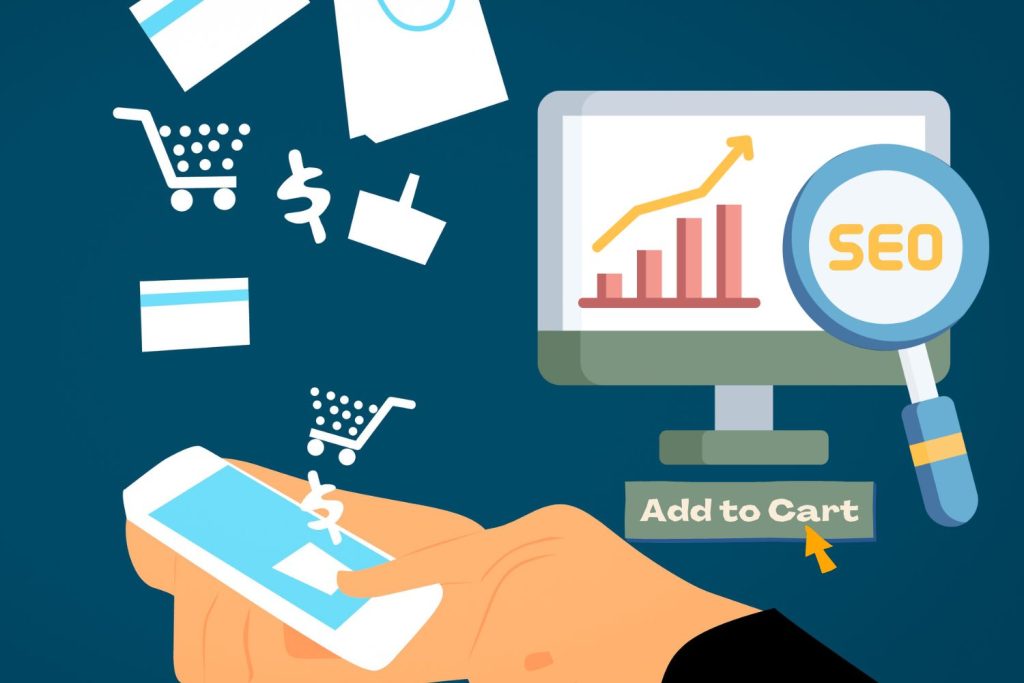In today’s digital economy, having a great product is no longer enough. You can have the best-designed clothing line, a game-changing gadget, or a beautifully packaged organic skincare set, but if no one can find it, you’re not in business. For e-commerce stores, SEO is just as important as product quality, branding, or customer service. Without it, you’re building a store in a quiet alley with no signage, no maps, and no word-of-mouth to bring anyone through the door.
This isn’t just about search engines. It’s about how people shop today, on their phones, on Google, on marketplaces, and how your products can reach them in that moment of intent. Whether you’re a local boutique expanding online or a large e-commerce operation with thousands of SKUs, SEO is the invisible engine that drives discoverability, credibility, and sales.
How SEO for E-Commerce Stores Impacts Real Sales, Not Just Rankings
When someone types into Google “best leather laptop bag under $200,” they’re not browsing for fun. They’re looking to buy, maybe not this minute, but soon. If your product page doesn’t appear for that kind of search, you’ve already lost the sale before you even knew it was possible.
And it’s not just about Google. Voice search, Google Shopping, image results, YouTube tutorials, they all rely on structured, optimized content behind the scenes. If your site isn’t built with that in mind, no one’s going to find your products in any of those places. That’s why
partnering with an experienced ecommerce web development company can ensure your website is designed for SEO success across all channels.

The Foundations of Effective E-Commerce SEO for Store Owners
The most common myth among product-based businesses is this: “If my product is good, people will buy it.” That only works if people can see it. And that visibility happens through SEO, long before a customer ever clicks “Add to Cart.”
When your store shows up high in Google’s search results, three things happen:
- You earn instant credibility. People trust what Google shows first. It feels more real than an ad.
- You capture people with intent. These aren’t passive browsers, they’re actively searching for something.
- You lower your cost per acquisition over time. Organic traffic, once earned, doesn’t require ongoing payment per click.
Let’s say you’re selling athletic footwear online. You’ve got a fantastic product, competitive pricing, and free shipping. But your product page for “Men’s Trail Running Shoes” is simply titled “Model X321.” There’s no descriptive text. No customer reviews. No real content. Google can’t tell what your page is about, and neither can your customers. That means you’re depending 100% on paid traffic to do the job SEO should have been doing all along.
Compare that to a well-optimized page titled “Waterproof Men’s Trail Running Shoes – Lightweight & Durable for All Terrain,” with a clear meta description, user reviews, structured data, and original content explaining how this shoe compares to alternatives. That’s not just more visible, it’s more persuasive.
What E-Commerce SEO Actually Looks Like in Practice
There’s no magic formula for SEO, but there is a repeatable framework that works across industries.
Start with the Right Pages
Most e-commerce store owners think SEO begins with the homepage. It doesn’t. Your highest-traffic potential lies in your product and category pages. These are the pages that match buyer searches.
Take category pages seriously. Instead of dumping 50 products under “T-shirts,” create keyword-optimized, readable content like:
“Our men’s cotton t-shirts are designed for comfort and breathability. Made from 100% organic materials, these tees are ideal for everyday wear, workouts, or casual nights out. Available in slim fit, relaxed fit, and extended sizes.”
This small paragraph alone helps Google understand what’s on the page, and keeps shoppers from bouncing.
Write Like a Real Person, Not a Machine
Avoid keyword stuffing. You don’t need to repeat “buy blue jeans Canada” ten times. You need to write like someone who’s trying to help a customer. Think about how someone searches, and match that intent naturally.
If someone types “best jeans for short men,” and you sell them, your page should talk about that:
“These jeans are cut with a tapered leg and a slightly shorter inseam, making them perfect for men 5’4” to 5’8”. No tailoring required.”
That’s real, relatable copy, and it ranks.

Use Structured Data, Even If You’re Small
Schema markup sounds technical, but it’s just a way to show Google the details. You’ve seen it in action: when you search and see star ratings, price, and stock status in the search result itself.
Adding this to your product pages helps your listing stand out and earns more clicks. Tools like Shopify or plugins like RankMath for WooCommerce can help you implement this without writing any code.
Focus on Speed and Mobile First
More than 65% of e-commerce traffic is mobile. If your site loads slowly, has clunky menus, or doesn’t work on a phone, users leave. Google notices, and your rankings drop. “A 1-second delay in load time can reduce conversions by up to 20%, according to Google research.
Compress your images. Limit pop-ups. Use lazy loading. Keep menus clean. Your best SEO strategy might be as simple as making your site actually usable.
Invest in Content That Answers Real Questions
Don’t just list products, solve problems. If you sell skincare, create a guide like “How to Build a Winter Skincare Routine for Dry Skin.” Link to relevant products within the guide. If you sell tech accessories, write “Top 5 Laptop Sleeves for Commuters.”
This type of content builds trust, keeps users on your site longer, and brings in traffic from broader keyword searches. It also gives you more room to use natural, longtail search phrases like:
- “eco-friendly skincare Canada”
- “durable charging cables for travel”
- “best dog collars for large breeds”
That’s the kind of traffic that converts.

What Happens When You Don’t Do SEO?
If you’re relying on social media or paid ads alone, you’re stuck on a treadmill. The minute you pause your budget, the traffic stops. SEO, on the other hand, builds momentum over time, creating lasting visibility that continues to attract visitors even when you’re not actively spending. Investing in professional SEO services helps you create that steady flow of organic traffic, so your store can grow sustainably without constantly chasing new ad budgets.
Without it:
- You’re invisible in Google’s organic results.
- Your competitors outrank you, sometimes with worse products.
- You pay more for each sale, driving up acquisition costs.
- Your product pages become islands, unconnected and unsearchable.
And if your competitors are investing in SEO while you’re not? It’s not just that they’re growing. It’s that they’re taking your potential customers before you even get a chance.
What Not to Do: SEO Mistakes That Hurt E-Commerce Stores
Here are common SEO mistakes e-commerce stores make, and why they hurt more than help:
- Using manufacturer’s product descriptions
Google filters out duplicate content. If your pages use the same text as dozens of other retailers, you’re invisible. Using manufacturer product descriptions across hundreds of pages risks being flagged as duplicate content, which can impact rankings. Write short, unique blurbs instead that actually speak to your customers. - Ignoring structured data (schema)
Without schema, your product info won’t show properly in search results. It means no star ratings, price tags, or in-stock labels. You’re missing valuable click-through opportunities. - No image alt text
Product images without alt text won’t show up in Google Images and are bad for accessibility. Descriptive alt tags help both search engines and real shoppers. - Overloading your homepage
Sliders, videos, and too many pop-ups slow your site down and confuse visitors. Speed is a ranking factor. Simplicity sells better. - Not optimizing for mobile
If your site is clunky on a phone, people bounce. Most shoppers start on mobile. If it’s hard to tap, scroll, or check out, you lose sales and ranking. Google has prioritized mobile-first indexing since 2019, meaning your mobile site experience directly affects visibility. - JavaScript-only filters
If your category filters (like size, color, brand) rely only on JavaScript, Google might not index them. That’s a missed SEO opportunity for hundreds of product variations. - Deleting products with no redirect
Removing sold-out products without redirecting the URL causes 404 errors. If someone linked to that page, you’ve just lost the SEO value. Always redirect to a relevant alternative or category. - Keyword stuffing
Shoving keywords into every sentence makes the content unreadable. It doesn’t work anymore. Google wants clear, helpful, natural writing. - Hiding content behind tabs
Some e-commerce sites hide key product info under expandable tabs. If it’s not visible by default, Google might not treat it as important. Keep critical content visible. - Neglecting internal linking
Many stores don’t link related products or categories. Internal links help users discover more and guide Google’s crawl. Every product page is an opportunity to point somewhere else helpful.
SEO Strategies for Every Size E-Commerce Store
Whether you’re running a niche Shopify store or managing a massive multi-brand online catalogue, SEO scales with you if you build it right. Here’s how to approach it based on your business type:
For Local Stores with an Online Presence
If you sell locally but have e-commerce capabilities (e.g., a bakery offering online cake orders or a pet supply store with curbside pickup), your SEO needs to combine local search with e-commerce visibility.
- Google Business Profile: Fully complete it. Add location, hours, service areas, FAQs, and updated photos. Many local searches end on this profile.
- Localized product pages: Mention specific areas in product descriptions. For example, “Natural dog food in Mississauga” or “Custom birthday cakes delivered in Vaughan.”
- Customer reviews: Ask happy buyers to leave Google and product-specific reviews. Both help rankings.
- Local schema: Mark up your pages with LocalBusiness and Product schema so Google knows where you operate and what you sell.

For Small to Mid-Sized E-Commerce Stores (Shopify, WooCommerce)
If you’re running a single-brand online store with under 1,000 SKUs, SEO is your long-term customer acquisition engine. Paid ads work fast, but SEO builds sustainable traffic. Whether you use Shopify, WooCommerce, or Magento, effective e-commerce stores utilizing SEO help your site get indexed, ranked, and clicked on.
- Use SEO-friendly themes and plugins: Tools like Yoast SEO (WordPress), Smart SEO (Shopify), and RankMath help with titles, meta descriptions, and structured data.
- Tight URL structure: Use clean, readable URLs like /t-shirts/women/organic-v-neck, avoid ?id=5829&ref=store4.
- Focus on product categories: Optimize category pages for broader keywords like “men’s waterproof jackets Canada.” Add short intro text, FAQs, and internal links.
- Blog with purpose: Create useful posts that match what buyers search. For example: “What size boxing gloves should I buy?” or “How to choose the right yoga mat thickness.”
- Fix crawl issues: Ensure your site has a working XML sitemap, robots.txt file, and minimal 404 errors. These are basic but often overlooked.
- Mobile performance: Use Shopify’s Lighthouse performance report or WooCommerce speed plugins to monitor load time. Google tracks this.
For Large, High-SKU Online Stores
If you’re managing thousands of SKUs across multiple categories or brands, like fashion retailers, electronics stores, or furniture platforms, SEO becomes a technical challenge. But the rewards are massive.
- Scalable architecture: Create SEO-friendly filter URLs that are indexable (e.g. /mens-shoes/running/nike/size-10). Don’t block filters in robots.txt unless necessary.
- Canonical tags: Prevent duplicate content issues by using proper canonical tags on filtered or sorted versions of the same category.
- Product lifecycle SEO: When items go out of stock or are discontinued, set up rules to redirect pages to updated models, related collections, or seasonal categories.
- Long-tail targeting at scale: Create landing pages for combinations like “red leather office chairs with headrest” or “organic cotton toddler pajamas Canada.” These convert better than broad terms.
- Multilingual or multi-region SEO: If you sell in different countries, set up hreflang tags, local currency pages, and translated content. A Canadian shopper shouldn’t land on a USD page by default.
- Log file analysis: Use log files to see how Googlebot crawls your site. Focus your crawl budget on high-value pages and fix any bottlenecks.
If You Can’t Be Found, You Can’t Sell
E-commerce success doesn’t come from luck or even product quality alone. It comes from being visible at the right moment, in the right place, for the right search. SEO is how you put your product in front of someone who’s already looking to buy.
The good news? It’s not rocket science. It’s just smart, honest work: clear product content, structured pages, helpful information, and a site that respects the user. When you do that, and keep doing it, Google rewards you, and customers find you.
And that’s where sales begin.


